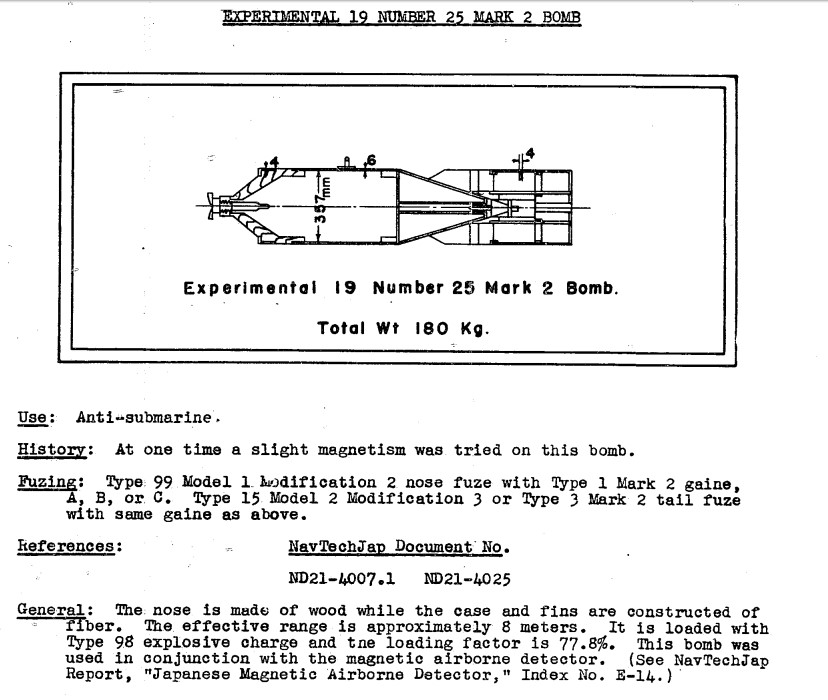The USN war damage report No58 from 1945 gives the following:
Three sizes of aerial depth bombs were developed by the Japanese Navy specifically for anti-submarine work and were used for this purpose by both Army and Navy aircraft.
These were designated by the Navy as Mark 2 bombs and by the Army as Type 4 bombs.
They were sometimes fitted with anti-ricochet nose rings and had considerably higher explosive-loading factors than ordinary general purpose bombs. The smallest of the three was a 60 Kg. bomb, designated by the Navy as the Type 99, No. 6, Mk. 2, Mods. 0 and 1, and was loaded with 85 pounds of Type 98 explosive. These small bombs were carried primarily by planes on routine anti-submarine patrol and were considered to have a lethal range of 12 to 15 feet.
The second was a 180 Kg. bomb designated as the Experimental 19, No. 25, Mk. 2, loaded with 308 pounds of Type 98 explosive. This bomb was developed primarily for use in conjunction with planes equipped with magnetic airborne detectors and was considered to have a lethal range of about 25 feet.
The third and largest was a 300Kg. (in the original report it was designated as 250kg , then corrected to 300kg) bomb designated as the Type 1, No. 25, Mk. 2, Model 1, Mods. 0 and 1, and was filled with 317 pounds of Type 98 explosive. This 300 Kg. bomb was considered to have a lethal range of about 33 feet and was generally only loaded on aircraft when a definite contact had been established by other planes or surface craft.
All three of the above Mark 2 depth bombs carried time rather than hydrostatic fuzes, and depth settings could only be varied by changing the fuze gaines prior to loading the bombs on aircraft.
Four different fuze gaines with different time delays were used for anti-submarine work, each of which could be used with all standard Navy bomb fuzes, which in turn would fit any of the three Mark 2 bombs.
The first gaine, the only variable setting design adopted by the Japanese, was designated as the Type 15 and could be set for detonation at any desired delay between 0 and 1.5 second after striking the surface of the water, equivalent to between 0 and about 50 foot depth.
The desired setting had to be selected prior to insertion of the gaine in the bomb fuze.
Although the Type 15 gaine was not developed specifically for anti-submarine bombs, it is known to have been used extensively for the purpose of attacking surfaced or submerging submarines.
Each of the other three fuze gaines had a pre-fixed time delay and all three were designated as the Type 1, Mark 2 design.
The Model 5 was set for detonation after 3.5 second delay, about 80 foot depth;
the Model 1A after 6 seconds delay, about 150 foot depth;
and the Model 1B after 17 seconds delay, about 300 foot depth.
The Japanese referred to bombs fitted with the Models 5 and 1A gaines as "25 meter" and "45 meter" bombs and these were the types generally carried, although the gaines were naturally varied to suit the expected conditions.
When anti-submarine Mark 2 Navy bombs were not available, the Japanese substituted common types of 60 Kg. and 250 Kg. Navy GP bombs or Army 50 Kg., 100 Kg., and 250 Kg., Type 3 bombs.
Army aircraft frequently carried a mixed load of their own Type 3 bombs along with Navy Mark 2 bombs, the Type 3 bombs being fuzed instantaneously, with short delays, or with a nose plug and a special 3.5 second delay tail fuze.
The experimental 180kg remained an experiment and apparently was not used in service. Here's a drawing of this bomb:

 Author
Topic: japanese aircraft depth charges (Read 1949 times)
Author
Topic: japanese aircraft depth charges (Read 1949 times)


